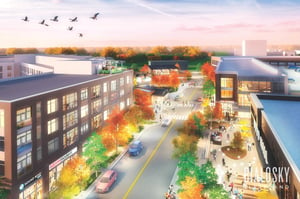The current concept of sustainable development was first presented in 1987 by the U.N. in the Brundtland Report (entitled Out Common Future) -- yet it didn't really take off until the 2000's when the terminology was catapulted into the public realm with the creation of the ubiquitous United Nations Sustainable Development Goals (SDGs) in 2012. The UN SDGs are now a common reporting framework for private companies, governments, and international initiatives. In fact, 74% of the world’s largest 250 companies report annually using the UN SDGs.
 The idea of sustainable development came as a response to the exponential economic growth that has been ongoing since the Industrial Revolution. Growth has been prioritized over the environment during this period, leading to many consequences. Displacing local communities, deforesting land for urbanization, and inefficient resource use are all common practices. As a result, the world now faces issues with no immediate solution, like poor air quality, degraded land, and climate change.
The idea of sustainable development came as a response to the exponential economic growth that has been ongoing since the Industrial Revolution. Growth has been prioritized over the environment during this period, leading to many consequences. Displacing local communities, deforesting land for urbanization, and inefficient resource use are all common practices. As a result, the world now faces issues with no immediate solution, like poor air quality, degraded land, and climate change.
Sustainable development is the solution. The United Nations defines sustainable development as “development that meets the needs of the present without compromising the ability of future generations to meet their own needs.” Simply put, it balances economic growth with the associated social and environmental impacts.
There Are 3 Primary Objectives of Sustainable Development:
1) Economic Growth: Building a strong, competitive economy that is sustainable and resilient. Economic success is a nuanced process that touches all parts of society. It includes ensuring sufficient land and resources are available for growth, effective government policies are in place to support innovation, and mitigating economic risks.
2) Environmental Protection: Contributing to protecting and enhancing our natural and developed environment. This includes helping improve biodiversity, using natural resources wisely, minimizing waste and pollution, and both adapting to and mitigating climate change.
3) Social Inclusion: Supporting strong, vibrant, and healthy communities. It includes providing a supply of housing to meet the needs of present and future generations and maintaining a high quality of development that reflects the community’s needs and supports its health, social, and cultural well-being.
 These are applied across all sectors of development, including:
These are applied across all sectors of development, including:
- urbanization
- agriculture
- infrastructure
- energy use
- water availability
- transportation
Implementing Sustainability
To achieve effective sustainable development, the 3 primary objectives must be applied simultaneously, interacting with one another in a consistent, committed effort. It requires a concerted effort with cities and companies embracing an array of sustainability initiatives that balance all three pillars.
And companies are willing to make an effort, particularly because data shows that sustainable companies see better long-term financial success. For example, building owners and developers are implementing more sustainably certified projects. The number of LEED BD+C registered projects is increasing at a rate of 20% per year, with over 36,000 registered projects covering 4.6 billion square feet of development already existing.
While some business cases for sustainable development are tied to reduced risk, another major consideration is the market. Consumers are more socially conscious than ever before and want products from sustainable companies. Recent studies found that 90% of Gen X consumers are willing to pay more for sustainable products, and 66% of all respondents consider sustainability in their purchasing. This is supported by a 71% increase in global internet search quantity for “sustainable goods” over the last five years.
The Future of Sustainable Development
Sustainable development practices help countries and businesses grow in ways that adapt to the challenges posed by climate change. This protects important natural resources for our current and future generations and allows communities to thrive.
Governments around the world realize this and are starting to implement regulations that support sustainable development and hold private companies accountable for their actions. In the U.S., the SEC has proposed a law requiring publicly listed companies to disclose climate-related information, including greenhouse gas emissions. Additionally, the U.S. government is including aspects of social inclusion in new policies. For example, the recent Inflation Reduction Act (IRA) includes incentives and benefits for non-profit entities and low-income housing.
As a result of these types of actions, social equality is improving. For example, the number of women and minority-owned businesses is rising. The number of women who started businesses during the pandemic doubled compared to the year before.
By the year 2050, it is estimated that our global population will likely reach 9 billion people. Sustainable development is necessary to maintain a livable world for each of these people.
Posts by Tag
- Sustainability (171)
- sustainability consulting (143)
- Energy Efficiency (126)
- Utilities (91)
- LEED (87)
- Sustainable Design (69)
- green building certification (59)
- energy audit (46)
- ESG (45)
- construction (43)
- GHG Emissions (36)
- WELL (32)
- carbon neutrality (31)
- net zero (27)
- tax incentives (27)
- costs (26)
- energy modeling (18)
- electric vehicles (17)
- Energy Star (14)
- Housing (14)
- Inflation Reduction Act (13)
- water efficiency (13)
- Social Equity (12)
- decarbonization (12)
- diversity (10)
- NGBS (7)
- fitwel (7)
- Earth Day (6)
- electrification (5)
- mass timber (5)
- non-profit (5)
- retro-commissioning (5)
- Emerald Gives (4)
- Engineering (4)
- News Releases (4)
- B Corp (3)
- COVID-19 Certification (3)
- Customers (3)
- Indoor Air Quality (3)
- PACE (3)
- Arc (2)
- DEI (2)
- EcoDistricts (2)
- EcoVadis (2)
- Green Globes (2)
- cannabis (2)
- CDP (1)
- SITES (1)
- furniture (1)
- opportunity zone (1)
- womenleaders (1)


